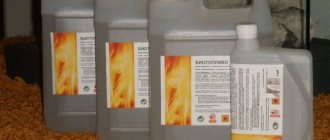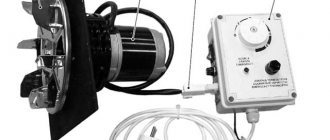Biofuel for the fireplace is made only from natural raw materials, which are a product of the vital activity of living organisms. It uses products of animal or plant origin. Biological waste is also often processed for these purposes. A remarkable feature of biofuel is that it is the best alternative fuel that does not require a chimney.
Eco-fireplace using biofuel does not require a chimney
Biofuel composition
Before moving on to a full review of biofuels, let's remember what they consist of. So, biofuel is alcohol (denatured ethanol). It is absolutely harmless to the environment and you, and when burned it breaks down into carbon dioxide and steam.
Produced by fermentation of wheat, cane sugar, beets, potatoes, etc. The combustion process of biofuels occurs without the release of soot, smoke and other products. By the way, some manufacturers also add flavorings to biofuel. The smell of pine, sea salt and coffee, for example. Below we will look at whether something like this is worth buying or not.
Despite all the environmental friendliness of the fuel, do not forget that denatured ethanol should never be taken orally, it can be fatal.
Now let's get back to our fuel review.
How biogas is produced
This type of fuel differs significantly from the bioethanol described above in composition, method of production and use. If desired, such a flammable substance can be produced on your own site. This gas is not suitable for an eco-fireplace, but it is quite successfully used for ordinary fireplaces equipped with special burners.
A biogas production plant is a sealed container into which raw materials are loaded and converted into a combustible mixture for heating homes or utility rooms.
Through them, not only biogas enters the combustion chamber, but also an additional flow of oxygen. This way you can ensure efficient combustion of biofuels. A fireplace intended to use biogas must have a chimney. This allows it to be used not only for burning gas, but also for more traditional types of fuel: wood, coal, etc.
If the house already has a fireplace, converting it to use biogas will not be particularly difficult. If you have enough firewood, you can make your own charcoal to save some money. It is possible to produce biogas from manure.
It must be mixed with products of plant origin: straw, peat, tree leaves, vegetable tops, sawdust, etc. This mixture is placed in a tightly closed container, where it ferments under the influence of bacterial cultures.
The result is a flammable gas that consists mainly of methane. It can be burned to heat residential premises, greenhouses, and utility rooms.
One of the mandatory requirements for a biogas plant is absolute tightness. Since the process is accompanied by the release of a characteristic stench, the fermentation container is installed underground.
A hose is brought outside through which the resulting gas flows. Another hose is needed to feed material inside for recycling. You can make a biogas generator yourself, but there are also industrial models that are safer and more productive.
Types of liquid biofuels and an overview of them based on 5 main points
Now, let’s look at all the pros and cons of biofuel for modern biofireplaces. For comparison, we purchased 5 biofuel options from different manufacturers from x-kamin.ru. This:
- 1"ZeFire"
- 2"Fanola"
- 3"LuxFire"
- 4"Profit"
- 5"FireBird"
Each of the 5 participants is a representative of Russian production. Which is good news, because they can be found everywhere.
So, what you need to pay attention to when choosing:
Review of popular brands
Biodiesel for automobiles is mainly produced in America (USA, Canada and Brazil), as well as India, China and Europe. This is often presented as concern for the environment and increased use of alternative energy sources.
But there is one caveat - to produce large volumes of biodiesel, large volumes of organic matter (corn, rapeseed, sugar cane) are required. However, large-scale cultivation of these crops consumes a lot of water and, again, fuel for agricultural machinery.
The output result is quite ambiguous. It’s one thing when waste is processed to make such fuel, and quite another thing is the processing of plants specially grown for this purpose.
The main ingredient of all brands of biofuel for fireplaces is alcohol; it does not have any particular differences in quality and composition between different manufacturers (+)
The situation with ethanol biofuel is somewhat different. It is produced on a much smaller scale. This is mainly done in Europe, but Russia also has its own factories. To produce this biofuel, raw materials of plant origin are also needed, but not in such huge volumes as in the case of the automobile analogue.
In domestic stores, you can choose fireplace biofuel from the following brands:
- Kratki BioDECO (Poland).
- InterFlame (Russia).
- BioKer (Russia).
- Planika Fanola (Germany).
- Vegeflame (France).
- Bionlov (Switzerland).
- Bioteplo Slimfire (Italy).
The choice is quite extensive. The price per liter ranges from 260–600 rubles. Cost often depends on the presence/absence and combination of additional additives. Some aromatic oils are quite expensive. Although they are present in biofuels in very small proportions, they still affect the price.
How to choose
When choosing fuel for biofireplaces, you need to pay attention to a number of factors:
- availability of certificates of conformity;
- indicator of productivity and energy capacity;
- absence of decomposition products in the fuel tank after combustion;
- absence of sharp and unpleasant odors from the liquid;
- best before date;
- authenticity of packaging;
1. Biofuel packaging. Why is it important?
It is the quality of the plastic bottle and the presence of a convenient cap with a valve that determines the constant comfortable use of this or that biofuel. For example, like samples No. 1 “ZeFire” and No. 3 “LuxFire”, but it is worth saying that the latter has an unstable bottle bottom, which is unsafe and inconvenient. No. 5 “FireBird” also has a problem with the base of the package; there is also no convenient valve, which allows you to forget about the additional use of a funnel.
Check out our bio fireplaces
Tabletop bio-fireplaces Floor-standing bio-fireplaces Built-in bio-fireplaces Fuel blocks Wall-mounted bio-fireplaces
use of biofuel with funnel
use of fuel without external means
2. Does the bio-fireplace smell? Scent or stink?
“We’ll buy biofuel, and then we’ll suffocate from the suffocating fumes...” is a very common misconception among buyers of biofireplaces. Our company Kronco carefully approached the coverage of this issue and tested each sample, as they say, on itself. You can watch in more detail in our video, where we clearly presented everything.
Now let’s briefly tell you that the smell of the purchased fuel depends solely on the composition, on the impurities that are added. But, one way or another, all this is alcohol, and therefore the smell of alcohol is present. When recording our review, it was found that samples No. 1 “ZeFire” and No. 4 “Profit” have a specific aroma similar to tequila. The rest of the options presented have the smell of pure alcohol.
3.Which fuel is better?
Which biofuel burns longer? Does it weather or not? What does the flame look like? We conducted 3 tests, the first on the rate of weathering, the second on the combustion of biofuel without filling the fuel block, the third on combustion with filling the fuel block with ceramic wool. What we got:
- 1Over the course of a day, 100 ml of each biofuel evaporated by 90%, only No. 1 “ZeFire” and No. 4 “Profit” had a slightly larger remainder than the others.
- 2When burning fuel in a block without filler, the leader was sample number 3 “LuxFire” - it lasted 43 minutes 58 seconds, the fastest burning was sample number 5 “FireBird” 38 minutes 40 seconds, the other three participants were 3-4 minutes behind the first .
- 3When testing the combustion of biofuel with filling, the longest burning was sample No. 1 “ZeFire” 1 hour 44 seconds, in second place was sample 4 “Profit” 57 minutes 30 seconds, in third place was sample 5 “FireBird” 57 minutes, in fourth place was sample 2 “Fanola” 55 minutes 30 seconds and on the fifth - sample 3 “LuxFire” 55 minutes. But it is worth clarifying that when using ceramic wool, you have to pour more fuel into the block.
4.Where to buy biofuel? It's all about its availability.
“You won’t find this biofuel during the day... Why should I go to Moscow every time to buy it?” - unfortunately, we often hear such questions, this is understandable; clients are worried that they will not be able to refuel their bio-fireplaces. But there is only one answer: “Use the services of online stores, as we did to conduct tests.” For example, you can buy biofuel here x-kamin.ru Fast delivery is guaranteed, the entire range is always in stock.
Can additives and flavorings be used separately?
This question often arises among device owners. Many manufacturers have provided separate dispenser cells for this, located near the burner. When the walls are heated, the poured essential oil begins to evaporate intensely, which leads to the appearance of a strong, persistent odor. This is not always appropriate: fireplace owners increasingly prefer the absence of foreign odors.
Rice. 10. Flavored biofuel from the Kratki brand
As for ready-made additives, it is recommended to use only those that are designed specifically for fireplaces and bioethanol. In such cases, it is more rational to buy biofuel with a smell than to dilute the liquid yourself. This ensures that the positive properties are maintained without risks.
5. Cost of fuel for a biofireplace.
Cost is an integral attribute of a purchase, so it’s worth studying the difference in the price segment in advance:
- 1For 1.5 liters of “ZeFire” you need to pay 440 rubles.
- 2For 1.5 liters of “Fanola” you will pay 600 rubles.
- 3For the same volume of “LuxFire” it will cost 450 rubles.
- 4The price of Profit biofuel turned out to be a little shocking; for the same 1.5 liters you will have to pay 810 rubles.
- 51.5 liters of FireBird biofuel will cost 410 rubles.
So, it turns out that basically all the samples are similar, and the only obvious disadvantage can be the price of biofuel, such as for sample number 2 “Fanola” and 4 “Profit”.
Gel fuel
There is another type of ethanol fuel - gel. Whether someone will try to use it for bio-fireplaces or not is unknown. But just in case, we’ll tell you why this shouldn’t be done.
“Gel fuel is used only in special gel biofireplaces. What it is and how it works, you can read in this article"
The fuel is sold in gel form or in tin cans, from which it cannot be taken out - only set on fire along with the contents. Either in plastic bottles - it is more often used for home fondue pots or for starting a fire at a barbecue.
So, under no circumstances should the latter be poured into the fuel block of a biofireplace running on bioethanol. Especially if you have a fuel block with filler. This gel is very thick, viscous, and if you try to light a fireplace with it, you will get a lot of problems - the filler simply will not absorb the gel fuel, but will only leave stains all over the block. Plus, the bio-fireplace itself is unlikely to light up where it is needed.
“If the fuel block is without filler, you can try pouring gel fuel into it. But just don’t overdo it with the quantity – the consequences are unknown, and the smell of alcohol in the gel fuel is too pronounced.”
Types of fuel
Biofuel is produced mainly in Europe and America. But Brazil occupies the leading place in its production. All fuels produced in the world can be divided into several types:
- biodiesel;
- bioethanol;
- biogas.
The first type of fuel is made from vegetable oils. Biogas is a kind of replacement for conventional gas produced during the processing of waste and household waste. Biodiesel also contains ethanol and easily replaces regular gasoline.
Biodiesel is produced during the processing of waste and household waste
Biodiesel is the best choice for a fireplace. For its production, vegetable oils of animal or microbial origin are used. The main composition of biofuels for fireplaces includes oils from:
- soy;
- palm trees;
- coconut;
- rapeseed
Biofuels are made from foods that contain a lot of sugar and starch.
In the production of fuel, the technology of processing ordinary algae is often used. This is mainly practiced by European manufacturers.
Almost any biofuel found can be represented by bioethanol. This ingredient is an alcohol that is formed during the fermentation and processing of carbohydrates. For this purpose, products that contain a lot of sugar and starch are used. Cellulose-containing raw materials can also be used. The finished liquid is colorless and should be odorless.
How much fuel does a biofireplace last? Biofuel consumption
Here it is impossible to calculate any average number and say that each biofireplace “eats” the same amount of fuel. How much fuel a fireplace will consume directly depends on the size of its fuel block.
We conducted an experiment: we poured fuel into blocks of different sizes and measured the amount of liquid that fit in them. And also did not forget to calculate how much money you will need for one hour of burning your bio-fireplace.
So, the 250 mm long block turned out to be the most economical (which is not surprising, since it is the smallest) - it holds 200 ml of fuel. An hour of burning requires approximately 0.7 liters of bioethanol. In monetary terms it is 245 rubles.
The 500 mm long block is the most popular among our customers. And it holds 1.2 liters of fuel. This is already 420 rubles for 1 hour of operation of the biofireplace.
An 800 mm block, as well as blocks measuring 1 and 1.2 meters, can accommodate from 2 to 2.5 liters of biofuel. This is 700-770 rubles for an hour-long fireplace burning session.
The winner in the fight was a block 1.5 meters long. You will have to fill it with 3.5 liters of fuel - this is 1120 rubles for 1 hour of operation of the biofireplace.
Useful information on eco-fireplaces
The device is an enlarged version of a conventional alcohol lamp with an impressive design. There is a container for loading flammable substances, as well as a damper to regulate the intensity of the flame. To decorate an eco-fireplace, ceramic elements, metal parts and heat-resistant glass are used.
Bioethanol burns without soot and soot, so eco-fireplaces do not need chimney structures, this simplifies their operation and makes them mobile
Glass panels not only decorate such a device, but also serve to protect against heat. Not all devices have such protection, but glass screens of various modifications are sold separately.
It makes sense to purchase a protective element, especially if you plan to use a mobile model that will be installed in different places. Often such a fireplace is decorated with artificial firewood to give the structure a traditional look, but this is not the only option.
Eco-fireplaces come in floor-mounted, table-top, wall-mounted and even tabletop types, they vary in size but work the same way.
You cannot add fuel to the eco-fireplace while it is operating. If bioethanol has been spilled, the contaminated surface should be cleaned immediately
Such devices can be used to heat a room or as interior decoration. The device does not require wires, so it can be easily moved. For example, on a cool summer evening, an eco-fireplace can be installed on an open veranda. There are devices of various shapes.
An interesting option for a stylish office could be a miniature model, the chamber of which is built into the tabletop, with only the lid protruding above the surface. There are interesting options in the form of a basket, an elongated cylinder, etc.
Since an eco-fireplace in which such biofuels are burned does not need to be equipped with a combustion product removal system, the heat generated during combustion is not lost to heating additional structures.
The basic design of an eco-fireplace is almost no different from a conventional alcohol lamp, so such a device is not difficult to make with your own hands
Therefore, it is believed that the efficiency of such a device is about 95%, a fairly high figure for any system. To operate a conventional eco-fireplace for an hour, half a liter of bioethanol is usually sufficient. At the same time, 6-7 kW/h of energy can be obtained from a liter of fuel.
It is believed that a standard eco-fireplace can successfully replace an electric heater of about three kilowatts.
Wall-mounted models of eco-fireplaces can imitate traditional devices; they are varied and provide many options for the interior design of an apartment or office.
The advantage of using a biofireplace compared to other heaters is that this device slightly increases the humidity in the room. Almost any traditional heating method, on the contrary, removes moisture, which can have a negative impact on people’s health.
Both eco-fireplace and bioethanol are very easy to use, and this fuel is no more dangerous than other flammable substances used in everyday life. The combustion of bioethanol can be regulated if the design of eco-fireplaces provides for such a possibility.
The device can provide more or less heat and light, and accordingly, the time of fuel consumption will change.
This heating method also has some disadvantages. For example, despite all the ease of use, bioethanol cannot be added to the fireplace container. You need to not only wait for the composition to burn out, but also let the device cool. This point will have to be taken into account when planning the time to use the fireplace.
Although bioethanol fireplaces do not require a chimney, such devices should not be used uncontrolled.
An open flame always poses a fire hazard, so it is best to hide it behind a heat-resistant glass screen. This item can be purchased separately
A room that is heated in this way must be regularly ventilated to balance the amount of oxygen and carbon dioxide. If a little fuel is spilled while refueling the fireplace, it must be wiped up immediately, even if it is only a couple of drops of flammable substance.
To do this, it is better to keep rags with good absorbent properties on hand. For ignition, it is allowed to use special long matches, but long metal lighters are more often used. Some biofuel fireplaces are equipped with an electric ignition function, which is very convenient, but increases the cost of the model.
“Is it possible to make biofuel with your own hands?”
We are afraid to imagine, but some people, it turns out, are trying to create biofuel with their own hands. Friends, this is impossible! Don't even try to do this at home, you're not Walter from Breaking Bad.
Yes, the composition of biofuel is simple - bioethanol, that is, alcohol and impurities. But this does not mean that you just need to buy ethyl alcohol and add something to it. Moreover, pure ethyl alcohol is prohibited for use in Russia (Resolution of the Chief State Sanitary Doctor of the Russian Federation dated March 27, 2022 N39 “On the suspension of retail trade in alcohol-containing non-food products, alcohol-containing food additives and flavorings”).
If you do find 96° medical alcohol, all you have to do is mix it with gasoline. On the Internet it is recommended to purchase the kind used for Zippo lighters. In the proportion of 1 liter of alcohol to 70-80 ml of gasoline. These substances have different densities, so you can’t just mix them in a jar. It is better to connect them before directly refueling the bio-fireplace. After lighting your homemade fuel, you can enjoy the wonderful smell of alcohol in the air! Of course, over time the smell will disappear, but the residue will remain.
Attracting clients
The highlight of the idea can be a design proposal. For example, the client himself comes up with a fireplace model, and the designer develops it taking into account his wishes. The product is created from a finished picture. Additional work with the client will increase the authority of the production among clients, and you can earn 15-20% more.
The main clients will be the following
- Private entrepreneurs.
- Designers and design companies.
- Private individuals.
You can sell yourself in several ways:
Do-it-yourself biofireplace manufacturing technology
Thanks to its simple structure, you can make a biofireplace with your own hands. Most often this is done by people who want to save money and not overpay. To make a bio-fireplace with a glass screen, you will need the following materials and tools:
- glass 3 mm thick;
- construction mesh made of metal;
- glass cutter;
- metal box;
- silicone based sealant;
- cotton cord for the wick;
- stones or pebbles;
- fuel for the fireplace.
The production of biofireplaces takes place in several stages:
First of all, they draw a rough diagram of the future bio-fireplace.
In the figure you need to roughly depict the diagram of the product and check the size compliance.
First, a glass screen is made. To do this, measure the size of the metal box into which the glass will be inserted. It is cut out using a glass cutter. You can also use scraps of timber and plywood as a base.
A glass screen is attached to a metal box, the parts of which are glued together with sealant.
- All edges of the future screen are treated with silicone sealant and pressed tightly. The glue sets very quickly. Excess sealant is carefully cut off with a blade.
- The construction mesh is cut to fit the size of the box.
- Fuel is placed in a pre-prepared metal container, placed in a box and covered with a mesh folded in several layers. In specialized stores you can buy special fuel - bioethanol. It does not produce smoke, soot or burning.
A fuel container is installed in the box. More complex designs use multiple fuel blocks.
Bioethanol is sold in special containers. Their volume is enough for several applications.
- A wick is lowered into an open can of fuel.
- Next, pebbles or small stones are laid on top of the mesh. They not only decorate the future fireplace, but also ensure uniform distribution of heat. Some decorate their creations with forged items or attributes reminiscent of wooden logs. All parts must be made of non-flammable material.
The finished bio-fireplace is decorated to your taste. Most often, decorative stones or pebbles are used. You can decorate a bio-fireplace with attributes that imitate wooden beams.
The glass casing is then attached to the box.
An example of a homemade bio-fireplace. The box is made of stainless steel. The glass casing must be at least 3 mm thick.
The finished bio-fireplace is placed in the chosen location.
The bio-fireplace, made in a glass case, will be an excellent table decoration.
The bio-fireplace will burn for several hours. To light the fireplace again, the fuel container is replaced with a new one. The fuel must be shaken before use.
How to save on biofuel? Transportation of fuel through a transport company
When delivering fuel by a transport company, remember: bioethanol belongs to the third class of the dangerous goods category. Before transportation, you will have to pay an additional “tax” for substances that are dangerous for transportation, prone to fire. Biofuel must be packaged properly and can only be transported by land.
To avoid unnecessary waste of money, it is better to order fuel immediately with a biofireplace and more. For large volumes, our manager can give you a discount, so you can save twice as much. We will pack the fuel and negotiate with the retailer, since we often send biofuel and know how to do it correctly.
Is it possible to dilute biofuel for a fireplace with water?
If you think that you can dilute the fuel with water to increase its quantity, and everything will be fine, you are mistaken. If you dilute the fuel with water, the water will simply appear at the top, and attempts to light the fireplace will be in vain.
You cannot independently add to biofuel (especially when burning a biofireplace) all sorts of chemical compounds that call for changing the color of the fire or that promise unforgettable aromatherapy. If foreign substances get in, it is unknown how the fire will behave, so we do not recommend it. If you really want to, online stores have a wide range of ready-made flavored fuels. Or you can use essential oils. Apply 2-3 drops of natural oil to the ceramic decorations of the bio-fireplace to give the desired aroma. Don't forget to ventilate the room.
By the way, of all the presented biofuel options, one stood out because of its composition, in which, in addition to bioethanol, water was added - this is sample number 5 “FireBird”. Is it good or bad? We didn't notice much of a difference.











